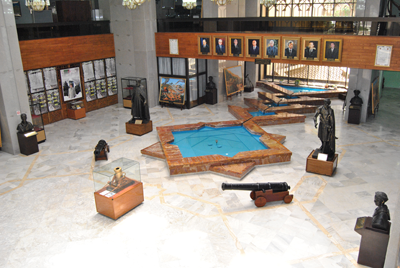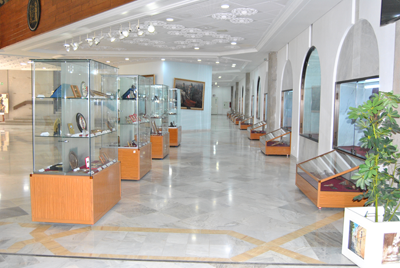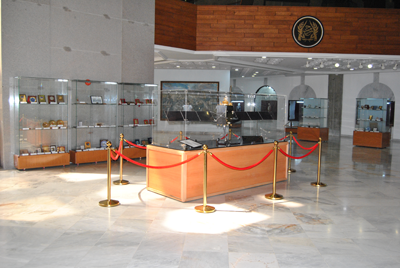From the antiquity to the twentieth century, the Algerian History is an extraordinary swarm of achievements, events and all sorts of movements. Nevertheless, in this diversity, sometimes unimaginable, exists a fact never denied: the secular struggle of the Algerian people for Independence and freedom. From the first Numidian Kings until the Revolution of November, an arduous and tenacious fight represents the key for understanding the Algerian Nation. This is the reason for the existence of the Central Museum of the Army, which was placed under the control of the Directorate of Information and Communication of People's National Army Staff.


Recently created, since it opened its doors to public on June 1985, the Central Museum of the Army has already provided a considerable work in the constitution of collections, time and efforts are given to do so.
The museum's surface area is about 20000 m2 in which more than 3000 objects and works are exhibited. In addition, to more than 2000 books, thousands of documents and archives that were collectedalong decades. So much, still, to do in order that the museum becomes the panorama of the Algerian Military History through ages. As the history which is proposed to be exhibited, the museum is a vivid institution in which an attractive and spectacular evolution shown. There are so much information to learn in the Central Museum of the Army, just in a pleasant afternoon. In addition to all the collections exhibited in the four floors, the museum disposes of a library for historical researches.

The Central Museum of the Army is situated in the south west of the complex of Ryadh El-Feth. Composed of a basement, a ground floor and 04 other floors.
- Workshops.
- Laboratories.
- Offices.
- Technical-Services rooms.
- 04 Stores.
- 02 Bring-up loads and an elevator.
The Basement
- A hall that leading to the conference room (265 seats) with modern equipment of translation.
- Entry leading to the patio where we find a library (with reading rooms)
- Memories shops.
- Stairs.
- Elevators (03)
- Bring-up loads (02)
The Ground Floor
- Area of exposition of 2700 m².
- 04 administrative stairs.
- 02 elevators.
- 02 bring-up loads.
2nd floor
- Area of exposition of 2700 m².
- Workshops.
- 03 stairs.
- 02 elevators.
3rd floor
The Location
This historical monument was built on top of the hill of El-Madania, Algiers within the socio-cultural center of Riadh El-Feth. It was constructed in an ancient district called "les acacias". The museum faces the martyr's memorial. Being close to each other, they symbolize the glorious history of the Algerian people. This place was the theatre of several operations crowned by the victory of our heroes, and where the children of this homeland witnessed the wildest torture practiced by the colonialism.- This place was also chosen for its historic importance because El-Madania extricates its name of the "brothers Madani»; heroes of the revolution. A Street was baptized by their name.
- This site was a military fort where the fleet of Charles the fifth, king of Spain, was destroyed when he attempted to land in R'mila (les sablettes), today called "Jardin d'Essai" in 1541.
- The historical meeting of the group of 22 in June17th, 1954, hold in El-Madania and precisely in Derriche Lyès' house, near the Central Museum of the Army. It constituted the first step in the itinerary of the Great Liberation War crowned by the Independence of the country.
- This place was chosen by the colonialism to implant the centers of torture where Lagaillarde ; the executioner made the Algerians suffer from the worse bodily cruelties such as the mayhem and crucifixion.





 Presentation
Presentation